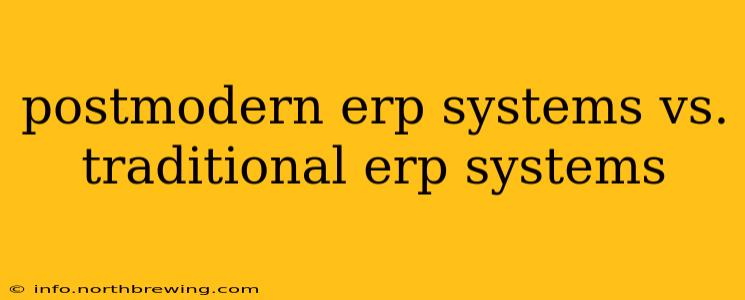The landscape of Enterprise Resource Planning (ERP) has undergone a dramatic transformation. What was once a monolithic, rigid system focused primarily on back-office functions has evolved into a more flexible, adaptable, and user-centric solution. This evolution marks the shift from traditional ERP systems to what many are calling postmodern ERP systems. This article delves into the key differences between these two approaches, highlighting the advantages and disadvantages of each.
What is a Traditional ERP System?
Traditional ERP systems, often implemented in the late 20th and early 21st centuries, were characterized by their monolithic architecture. These systems were typically large, complex, and difficult to implement. They often involved lengthy customization processes and significant upfront investment. Key features included:
- On-premise deployment: The software resided on the company's own servers, requiring significant IT infrastructure investment.
- Limited flexibility: Changes and customizations were time-consuming and expensive.
- Integration challenges: Integrating with other systems was often difficult and required specialized skills.
- Focus on back-office functions: The primary focus was on streamlining internal processes like accounting, inventory management, and human resources.
- Complex user interface: Often difficult for non-technical users to navigate and understand.
While these systems offered improvements in efficiency and data management, they often lacked agility and struggled to adapt to rapidly changing business environments.
What are Postmodern ERP Systems?
Postmodern ERP systems represent a significant departure from their predecessors. They are built on modern architectural principles, emphasizing flexibility, scalability, and user experience. Key differentiators include:
- Cloud-based deployment: Software resides on cloud servers, reducing upfront investment and IT infrastructure needs. This enables quicker implementation and easier scalability.
- Modular architecture: Systems are built from individual modules that can be implemented and customized as needed, allowing for greater flexibility.
- Improved user experience: Intuitive interfaces and user-friendly dashboards empower both technical and non-technical users.
- Enhanced integration capabilities: Seamless integration with other systems, including CRM, marketing automation, and supply chain management tools, is a core feature.
- Focus on business outcomes: Rather than just automating processes, postmodern ERP systems aim to drive business outcomes by providing real-time insights and data-driven decision-making capabilities.
- Artificial intelligence (AI) and machine learning (ML) integration: Modern systems are often equipped with AI and ML capabilities to automate tasks, predict future trends and optimize business processes.
- Emphasis on agility and adaptability: The modular design allows for quick adaptations to changing market conditions and business requirements.
What are the Advantages of Postmodern ERP Systems over Traditional Systems?
Postmodern ERP systems offer several key advantages over their traditional counterparts:
- Lower Total Cost of Ownership (TCO): Cloud-based deployment reduces upfront investment and ongoing maintenance costs.
- Increased Agility and Adaptability: Modular design allows for quicker response to changing market conditions.
- Improved User Experience: User-friendly interfaces enhance productivity and user satisfaction.
- Enhanced Collaboration: Seamless integration facilitates better collaboration across departments.
- Better Data Insights: Real-time data analytics enable data-driven decision making.
- Scalability: Easily scale up or down resources as needed.
What are the Disadvantages of Postmodern ERP Systems?
While postmodern ERP systems offer numerous advantages, some potential drawbacks include:
- Dependence on Internet Connectivity: Cloud-based systems require a reliable internet connection.
- Vendor Lock-in: Switching vendors can be complex and expensive.
- Security Concerns: Data security is a critical concern, requiring robust security measures.
- Complexity of Integration: While integration is improved, integrating numerous systems can still pose challenges.
- Cost of Implementation: While potentially lower overall, initial implementation can still be expensive depending on the complexity and customization needed.
Are Postmodern ERP Systems Right for Every Business?
The choice between a traditional and a postmodern ERP system depends heavily on the specific needs and characteristics of the business. Small businesses with simpler needs might find traditional systems sufficient, while larger enterprises with complex operations and a need for greater agility will likely benefit from a postmodern approach.
What are the Key Differences Between Cloud-Based and On-Premise ERP Systems?
This question addresses a core difference between postmodern and traditional ERP. Cloud-based (postmodern) systems are hosted on the vendor's servers, accessible via the internet, whereas on-premise (traditional) systems reside on the company's internal servers. This impacts cost, maintenance, scalability, and security.
How Can I Choose the Right ERP System for My Business?
Choosing the right ERP system involves a careful assessment of your business needs, budget, and technical capabilities. Consider factors like company size, industry, existing IT infrastructure, and future growth plans. Consult with ERP experts to determine the best fit.
What is the Future of ERP Systems?
The future of ERP points towards even greater integration with AI, ML, and other emerging technologies. Expect systems to become increasingly intelligent, adaptive, and user-centric, driving greater efficiency and delivering more actionable insights.
This article provides a comprehensive overview of the differences between postmodern and traditional ERP systems. Remember to conduct thorough research and consult with professionals to determine the best ERP solution for your specific business needs.
